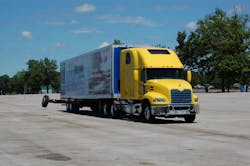As product manager for tire pressure monitoring systems (TPMS) at Bendix, Jon Intagliata intimately knows how even a small difference in tire inflation pressures can reduce fuel economy and decrease expected tire life and the dangerous those conditions can create..
It’s common knowledge that the right tire inflation pressure is a major factor in vehicle safety, tire life, fuel efficiency, and operating costs. Less frequently discussed, though, is the specific issue of pressure imbalance in dual-tire wheel-ends
While a low-pressure tire can be pretty easy to spot on a standard car, the more robust engineering of commercial truck tires and the arrangement of dual-tire wheel-ends make it more difficult to visibly notice such underinflation.
And it doesn’t take much less air in a tire to have significant negative impact: Tire underinflation by as little as 10% results in a 1.5% drop in fuel economy, and underinflation by 20% results in a 30% reduction in tire life.
Yet few can tell at a glance the difference between a truck tire that’s running a bit low at 95 psi [pounds per square inch] and one inflated properly at 105 psi – but that is all takes to start accelerating wear. Add in the fact that safety components – ranging from brakes to stability and collision mitigation systems – can’t perform to their optimal capabilities if tires are not operating in their proper condition.
The stakes become even greater in dual-tire arrangements, because if the pressure between both tires is not equal, one tire will wind up carrying a greater share of the load and do more work than the other. In addition, their sizes will be slightly different and as the tire assembly rotates, the smaller tire will drag, causing premature wear.
In short, running imbalanced duals increases the odds of a blowout on the overloaded tire and significantly shortens tire life on the underinflated tire. Industry data has shown that the pressure difference at which this becomes an issue can be as little as 5 psi. This small difference in pressure creates a difference in the tire’s circumference and causes the smaller tire to be dragged by the larger tire, producing accelerated or irregular wear.
While addressing dual-tire imbalance is simple enough – it’s just a matter of setting the tires to the right pressure, which is routine maintenance – noticing it in the first place can be trickier.
This is especially true for the inner dual which is masked by the outer tire, making it very difficult to spot a problem.
The best tool for tracking proper tire psi is a tire pressure monitoring system. These vary in design but operate in the same general fashion, using sensors mounted at each wheel-end of a tractor or trailer to constantly measure a tire’s pressure. If the sensor is mounted inside the tire, it can also measure temperature.
Note: Checking tires only when they are cool is not always convenient or feasible, and temperature compensation is important to ensure that tire pressure is able to be monitored over a long trip.
The more real-time information and alerts a system can provide, the better equipped a driver is out on the road, and the safer the truck becomes because a steel-belted truck tire blowout can do damage on several levels, from harming wheel-end components to vehicle downtime to causing an accident.
Simply paying attention to the details of correct inflation, tire temperature, and dual-tire pressure balance can help keep vehicles on the road and in good operating condition, reducing the odds of a catastrophic failure, and improving highway safety.
About the Author
Jon Intagliata
Jon Intagliata is VP of aftermarket and trailer for Bendix.
